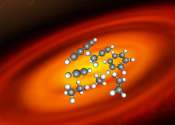Making Jupiters
IC348 is a glowing nebula of young stars, hot gas, and cold dust seen in the direction of the constellation of Perseus. It is the nearest rich cluster of young stars to earth, being only about one thousand light-years away. ...

IC348 is a glowing nebula of young stars, hot gas, and cold dust seen in the direction of the constellation of Perseus. It is the nearest rich cluster of young stars to earth, being only about one thousand light-years away. ...
Astronomy
Aug 21, 2009
3
0

Planets form in disks of gas and dust, orbiting young stars. The MIRI Mid-INfrared Disk Survey (MINDS), led by Thomas Henning from the Max Planck Institute for Astronomy (MPIA) in Heidelberg, Germany, aims to establish a ...
Astronomy
Jun 6, 2024
0
360

A team of astronomers and astrophysicists affiliated with several institutions in China, working with one colleague from Centro Ricerche Enrico Fermi, in Italy, and another from the University of Utah, in the U.S., has found ...

After nearly a decade of development, construction, and testing, the world's most advanced instrument for directly imaging and analyzing planets around other stars is pointing skyward and collecting light from distant worlds.
Astronomy
Jan 7, 2014
4
0

(Phys.org)—A star thought to have passed the age at which it can form planets may, in fact, be creating new worlds. The disk of material surrounding the surprising star called TW Hydrae may be massive enough to make even ...
Astronomy
Jan 30, 2013
2
0

New theoretical modeling by Carnegie's Alan Boss provides clues to how the gas giant planets in our solar system—Jupiter and Saturn—might have formed and evolved. His work was published recently by the Astrophysical Journal.
Astronomy
Mar 5, 2013
0
4

A new image of the disk of gas and dust around a sun-like star has spiral-arm-like structures. These features may provide clues to the presence of embedded but as-yet-unseen planets.
Astronomy
Oct 19, 2011
2
0

Giant planets that developed early in a star system's life could solve a mystery of why spiral structures are not observed in young protoplanetary discs, according to a new study by University of Warwick astronomers.
Astronomy
Nov 26, 2020
0
799

Planets form from the gas and dust in disks that surround young stars. Chemicals in the disk that evaporate easily, called volatiles, include important molecules like water, carbon monoxide, nitrogen, as well as other simple ...
Astronomy
Sep 11, 2020
1
409

Astronomers this month released the largest collection of sharp, detailed images of debris disks around young stars, showcasing the great variety of shapes and sizes of stellar systems during their prime planet-forming years. ...
Astronomy
Jun 24, 2020
0
279